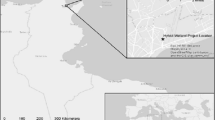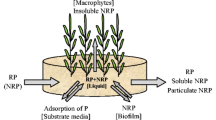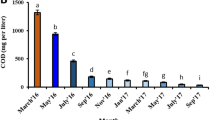Abstract
Seasonal changes (e.g., temperature, photoperiod, microbial activity) can affect treatment performance of constituents (oil, Cd, Cu, Ni, and Zn) in a constructed wetland treatment system (CWTS). The purpose of this research was to measure seasonal differences in performance of a hybrid free water surface CWTS for renovating simulated fresh oil field-produced water (FOPW) for surface water discharge and irrigation. The hybrid CWTS was constructed outdoors and consisted of an oil/water separator and two pilot-scale wetland series with four cells each. Oil removal activity (oil-specific agar plates) as well as acid-volatile sulfide (AVS) and simultaneously extractable metal concentrations were measured in the laboratory. For this experiment, water temperatures ranged from 0 to 30.2 °C in the wetland cells. There were no measurable seasonal differences in performance during this study. From inflow to outflow, the hybrid CWTS decreased oil marker compound concentrations by ≥99 % and Cd, Cu, Ni, and Zn concentrations by ≥98 %. There were no significant (p ≥ 0.5634) differences in biodegradation activity of oil nor in production of AVS during the year-long study, which supported our findings of consistent removal of the targeted constituents. With a hydraulic retention time of 4 days, oil marker compound and Cd concentrations in the treated simulated FOPW were greater than surface water discharge criteria, but did not cause toxicity to Ceriodaphnia dubia and Pimephales promelas (e.g., decreased survival or reproduction). Data from this pilot-scale hybrid CWTS indicated that performance goals for the removal of targeted constituents from simulated FOPW could be achieved throughout a seasonal study.





Similar content being viewed by others
References
Akratos, C. S., & Tsihrintzis, V. A. (2007). Effect of temperature, HRT, vegetation and porous media on removal efficiency of pilot-scale horizontal subsurface flow constructed wetlands. Ecological Engineering, 29, 173–191.
Alley, B. L., Beebe, D. A., Rodgers, J. H., Jr., & Castle, J. W. (2011). Chemical and physical characterization of produced water from conventional and unconventional fossil fuel resources. Chemosphere, 85, 74–82.
American Public Health Association (APHA), American Water Works Association, & Water Pollution Control Federation. (2005). Standard methods for examination of water and wastewater (21st ed.). Washington, D.C.: American Public Health Association.
American Society of Testing and Materials (ASTM). (2011). Standard practices for sampling of waterborne oils. ASTM D4489-95. Easton: ASTM.
Atlas, R. M., & Bartha, R. (1998). Microbial ecology. Fundamentals and applications. Menlo Park: Addison–Wesley Longman.
Ayers, R.S., & Westcot, D.W. (1994). Water quality for agriculture. FAO irrigation and drainage. Paper, vol. 29. Rome: FAO.
Bachand, P. A., & Horne, A. J. (2000). Denitrification in constructed free-water surface wetlands: II. Effects of vegetation and temperature. Ecological Engineering, 14, 17–32.
Brouwer, H., & Murphy, T. P. (1994). Diffusion method for the determination of acid-volatile sulfides (AVS) in sediment. Methods. Short communication. Environmental Toxicology and Chemistry, 13, 1273–1275.
Castaldi, P., Santona, L., & Melis, P. (2005). Heavy metal immobilization by chemical amendments in a polluted soil and influence on white lupin growth. Chemosphere, 60, 365–371.
Choi, J., Park, S., & Jaffé, P. (2006). The effect of emergent macrophytes on the dynamics of sulfur species and trace metals in wetland sediments. Environmental Pollution, 140, 286–293.
Cooney, J. J., Silver, S., & Beck, E. (1985). Factors influencing hydrocarbon degradation in three freshwater lakes. Microbial Ecology, 11, 127–137.
DiToro, D. M., Mahony, J. D., Hansen, D. J., Scott, K. J., Carlson, A. R., & Ankley, G. T. (1992). Acid volatile sulfide predicts the acute toxicity of cadmium and nickel in sediments. Environmental Science and Technology, 26, 96–101.
Fakhru'l-Razi, A., Pendashteh, A., Abullah, L. C., Biak, D. R., Madaeni, S. S., & Abidin, Z. Z. (2009). Review of technologies for oil and gas produced water treatment. Journal of Hazardous Materials, 170, 530–551.
Faulkner, S. P., Patrick, W. H., Jr., & Gambrell, R. P. (1989). Field techniques for measuring wetland soil parameters. Soil Science Society of America Journal, 53, 883–890.
Faulwetter, J. L., Gagnon, V., Sundberg, C., Chazarenc, F., Burr, M., Brisson, J., et al. (2009). Microbial processes influencing performance of treatment wetlands: a review. Ecological Engineering, 35, 987–1004.
Hadad, H. R., & Maine, M. A. (2007). Phosphorus amount in floating and rooted macrophytes growing in wetlands from the Middle Paraná River floodplain (Argentina). Ecological Engineering, 31, 251–258.
Hambrick, G. A., III, DeLaune, R. D., & Patrick, W. H. (1980). Effect of estuarine sediment pH and oxidation-reduction potential on microbial hydrocarbon degradation. Applied and Environmental Microbiology, 40, 365–369.
Ho, K., McKinney, R., Kuhn, A., Pelletier, M., & Burgess, R. (1997). Identification of acute toxicants in New Bedford Harbor sediments. Environmental Toxicology and Chemistry, 16, 551–558.
Huang, J., Reneau, R. B., Jr., & Hagedorn, C. (2000). Nitrogen removal in constructed wetlands employed to treat domestic wastewater. Water Research, 34, 2582–2588.
Ijah, U. J. J. (1998). Studies on relative capabilities of bacterial and yeast isolates from tropical soil in degrading crude oil. Waste Management, 18, 293–299.
Inoue, T., & Tsuchiya, T. (2008). Interspecific differences in radial oxygen loss from the roots of three Typha species. Limnology, 9, 207–211.
Jackson, A., & Pardue, J. (1997). Seasonal variability of crude oil respiration potential in salt and fresh marshes. Journal of Environmental Quality, 26, 1140–1146.
Josselyn, M. N., Faulkner, S. P., & Patrick, W. H. (1990). Relationships between seasonally wet soils and occurrence of wetland plants in California. Wetlands, 10, 7–26.
Kadlec, R. H. (1999). Chemical, physical and biological cycles in treatment wetlands. Water Science and Technology, 40, 37–44.
Kadlec, R. H. (2003). Effects of pollutant speciation in treatment wetlands design. Ecological Engineering, 20, 1–16.
Kadlec, R. H., & Knight, R. L. (1996). Treatment wetlands. Boca Raton: Lewis.
Kadlec, R. H., & Reddy, K. R. (2001). Temperature effects in treatment wetlands. Water Environment Research, 73, 543–557.
Kadlec, R. H., & Wallace, S. D. (2008). Treatment wetlands (2nd ed.). Boca Raton: CRC.
Korda, A., Santas, P., Tenente, A., & Santas, R. (1997). Petroleum hydrocarbon bioremediation: sampling and analytical techniques, in situ treatments and commercial microorganisms currently used. Applied Microbiology and Biotechnology, 48, 677–686.
Kosolapov, D. B., Kuschk, P., Vainshtein, M. B., Vatsourina, A. V., Wiessner, A., Kästner, M., et al. (2004). Microbial processes of heavy metal removal from carbon-deficient effluents in constructed wetlands. Eng. Life Sci., 4, 403–411.
Leahy, J., & Colwell, R. (1990). Microbial degradation of hydrocarbons in the environment. Microbiological Reviews, 54, 305–315.
Leonard, E. N., Cotter, A. M., & Ankley, G. T. (1996). Modified diffusion method for analysis of acid volatile sulfides and simultaneously extracted metals in freshwater sediment. Short communication. Environmental Toxicology and Chemistry, 15, 1479–1481.
Li, N., & Lee, H. K. (2001). Solid-phase extraction of polycyclic aromatic hydrocarbons in surface water: negative effect of humic acid. Journal of Chromatography. A, 921, 255–263.
Lloyd, P. B., Ganesan, S., & Lim, P. K. (1989). Segregation of metals at the oil-water interface: results and implications. Industrial and Engineering Chemistry Research, 28, 577–584.
Lundstedt, S., White, P., Lamieux, C., Lynes, K., Lambert, I., Oberg, L., et al. (2007). Sources, fate and toxic hazards of oxygenated polycyclic aromatic hydrocarbons (PAHs) at PAH-contaminated sites. Ambio, 36, 475–485.
Mæhlum, T., & Stålnacke, P. (1999). Removal efficiency of three cold-climate constructed wetlands treating domestic wastewater: effects of temperature, seasons, loading rates and input concentrations. Water Science and Technology, 40, 273–281.
Matthiessen, P., Thain, J., Law, R., & Fileman, T. (1993). Attempts to assess the environmental hazard posed by complex mixtures of organic chemicals in UK estuaries. Marine Pollution Bulletin, 26, 90–95.
Mayo, A., & Noike, T. (1996). Effects of temperature and pH on the growth of heterotrophic bacteria in waste stabilization ponds. Water Research, 30, 447–455.
Miller, D. J., Hawthorne, S., Gizir, A., & Clifford, A. (1998). Solubility of polycyclic aromatic hydrocarbons in subcritical water from 298 K to 498 K. J. Chem. Eng. Data, 43, 1043–1047.
Murray-Gulde, C. L., Huddleston, G. M., III, Garber, K. V., & Rodgers, J. H., Jr. (2005). Contributions of Schoenoplectus californicus in a constructed wetland system receiving copper contaminated wastewater. Water, Air, and Soil Pollution, 163, 355–378.
Nijhawan, N., & Myers, J. E. (2006). Constructed treatment wetlands for the treatment and reuse of produced water in dry climates. Society of Petroleum Engineers, Paper 98567.
Nixon, S., Granger, S., Buckley, B., Lamont, M., & Rowell, B. (2004). A one hundred and seventeen year coastal water temperature record from Woods, Hole, Massachusetts. Estuaries, 27, 397–404.
Reddy, G. B., Hunt, P. G., Phillips, R., & Grubbs, A. (2001). Treatment of swine wastewater in marsh-pond-marsh constructed wetlands. Water Science and Technology, 44, 545–550.
Reddy, M. S., Basha, S., Joshi, H., & Jha, B. (2005). Evaluation of the emission characteristics of trace metals from coal and fuel oil fired power plants and their fate during combustion. Journal of Hazardous Materials, B123, 242–249.
Rodgers, J. H., Jr., & Castle, J. W. (2008). Constructed wetland systems for efficient and effective treatment of contaminated waters for reuse. Environmental Geosciences, 15, 1–8.
SAS Institute. (2002). Statistical analysis system. Version 9.2. Cary: SAS Institute.
Siron, R., Rontani, J. F., & Giusti, G. (1987). Chemical characterization of a water soluble fraction (WSF) of crude oil. Toxicological and Environmental Chemistry, 15, 223–229.
Sorrell, B. K., & Armstrong, W. (1994). On the difficulties of measuring oxygen release by root systems of wetland plants. Journal of Ecology, 82, 177–183.
Spieles, D. J., & Mitsch, W. J. (2000). The effects of season and hydrologic and chemical loading on nitrate retention in constructed wetlands: a comparison of low- and high-nutrient riverine systems. Ecological Engineering, 14, 77–91.
Stein, O. R., & Hook, P. B. (2005). Temperature, plants, and oxygen: how does season affect constructed wetland performance? Journal of Environmental Science and Health, 40, 1331–1342.
Stein, O., Borden-Stewart, D., Hook, P., & Jones, W. (2007). Seasonal influence of sulfate reduction and zinc sequestration in subsurface treatment wetlands. Water Research, 41, 3440–3448.
USEPA. (1985). Seed germination/root elongation toxicity test. Title 40, code of federal regulations, part 797, section 2750 (pp. 740–744). Washington, D.C: United States Environmental Protection Agency.
USEPA (1996). Seed germination/root elongation toxicity test. EPA 712–C–96–154. United States Environmental Protection Agency, Washington, D.C.
USEPA. (1999). Analytical methods—method 1664, revision A: n-hexane extractable material (HEM; oil and grease) and silica gel treated n-hexane extractable material (SGT-HEM; non-polar material) by extraction and gravimetry. EPA-821-R-98-002. Washington, D.C.: United States Environmental Protection Agency.
USEPA. (2002). Short-term methods for estimating the chronic toxicity of effluents and receiving water to freshwater organism. EPA/821/R-02/013. Washington, D.C.: United States Environmental Protection Agency.
USEPA. (2007). Aquatic life ambient freshwater quality criteria—copper. Washington, D.C: Office of Water, United States Environmental Protection Agency. EPA-822-R-07-001.
USEPA. (2012). National recommended water quality criteria. Washington, D.C.: Office of Water, Office of Science and Technology, United States Environmental Protection Agency.
USGS (2006). Produced water database. United States Geological Survey. Maintained by: Central Energy Data Management. http://energy.cr.usgs.gov/prov/prodwat/data.htm
Venosa, A., & Zhu, X. (2003). Biodegradation of crude oil contaminating marine shorelines and freshwater wetlands. Spill Science & Technology Bulletin, 8, 163–178.
Vymazal, J., Brix, H., Cooper, P., Raimund, R., Perfler, R., & Laber, J. (1998). Removal mechanisms and types of constructed wetlands. In J. Vymazal, H. Brix, P. F. Cooper, M. B. Green, & R. Hubert (Eds.), Constructed wetlands for wastewater treatment in Europe. Leiden: Backhuys.
Werker, A. G., Dougherty, J., McHenry, J., & Van Loon, W. (2002). Treatment variability for wetland wastewater treatment design in cold climates. Ecological Engineering, 19, 1–11.
Wetzel, R. G. (2001). Limnology: Lakes and river ecosystems (3rd ed.). New York: Academic.
Acknowledgments
This material is based upon work supported by the Department of Energy under Award Number DE-NT0005682. This paper was prepared as an account of work sponsored by an agency of the US Government. Neither the US Government nor any agency thereof, nor any of their employees, makes any warranty, express or implied, or assumes any legal liability or responsibility for the accuracy, completeness, or usefulness of any information, apparatus, product, or process disclosed, or represents that its use would not infringe privately owned rights. Reference herein to any specific commercial product, process, or service by trade name, trademark, manufacturer, or otherwise does not necessarily constitute or imply its endorsement, recommendation, or favoring by the US Government or any agency thereof. The views and opinions of authors expressed herein do not necessarily state or reflect those of the US Government or any agency thereof. We gratefully acknowledge funding provided by Clemson University and the Department of Energy through the National Energy Technology Laboratory.
Author information
Authors and Affiliations
Corresponding author
Rights and permissions
About this article
Cite this article
Alley, B.L., Willis, B., Rodgers, J. et al. Seasonal Performance of a Hybrid Pilot-Scale Constructed Wetland Treatment System for Simulated Fresh Oil Field-Produced Water. Water Air Soil Pollut 224, 1639 (2013). https://doi.org/10.1007/s11270-013-1639-5
Received:
Accepted:
Published:
DOI: https://doi.org/10.1007/s11270-013-1639-5




